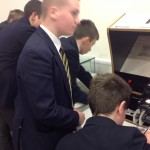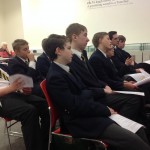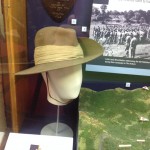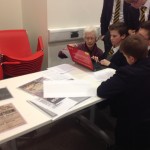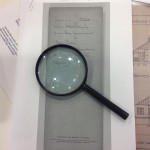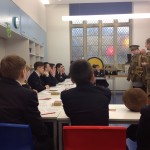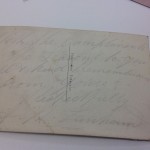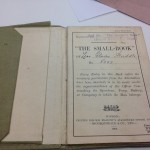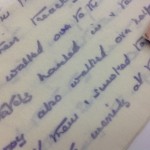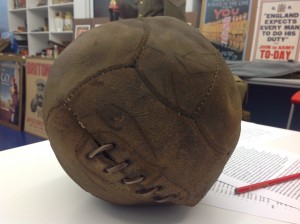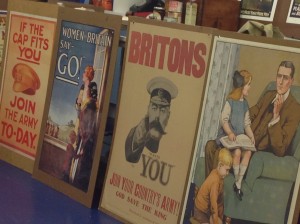First World War Timeline for Swale by Tom Saunders, Connor Wade and Will Plumb
Monthly Archives: March 2014
Peter and John from the Living History Project joined our group to lead a fascinating discussion on the conditions experienced by soldiers in WWI. Peter and John also were able to give us a number of pointers as to what direction we might take our project – Thank you Peter and John!
On Thursday 6th March the High Weald Academy group enjoyed a fantastic day in London. We took in some relevant memorial sites, then saw a matinee production of War Horse. All the group were profoundly moved by the theatricality and sensitivity of the play and it shed a great deal of light on conditions experienced by many in WWI.
SCHOOL PLAYING FIELDS
TWINNED WITH
PEACE VILLAGE AND FLANDERS PEACE FIELDS
National Children’s Football Alliance and the Peace Village, Mesen, Belgium, are commemorating WW1 and celebrating peace through the 1914 Christmas Truce by offering schools, clubs and public play areas with the opportunity to twin a designated area of play with Flanders Peace Fields, site of the Christmas Truce. This is open to all schools, clubs and public play areas across United Kingdom and Republic of Ireland.
This unique offer will directly link your area of play with one of the most famous fields in world history. Flanders Peace Fields lend themselves to education in a way that brings cultures, young and old together. Click here for the 3 key steps in how to apply for your Peace Field Declaration.
In the week leading up to Christmas 1914 groups of German, British and alley soldiers stopped fighting to sing festive songs. Some on Christmas Eve and Christmas Day ventured in to “No man’s land” to exchange gifts and to play games of football.
Today the truce is remembered as a symbolic moment of peace and humanity. An action taken by soldiers caught up in the conflict that was The First World War. Arguably, the horrors of war made men turn to a form of childhood to play a game of football to momentarily forget their tragic situation. It was a humanitarian act that every child and adult needs to engage in together.
Hosted by South East Grid for Learning & National Children’s Football Alliance
Kent & Medway Schools’ 1914 Christmas Truce Project
The Kent Schools’ 1914 Christmas Truce will take place across Kent & Medway during the week of the 24th – 28th November 2014. It is an opportunity for schools and their pupils to:
- Research and find out if soldiers from their local area took part in this special event
- Plan a 1914 Christmas Truce Assembly
- Write and publish poems, postcards and Christmas Greeting cards like the soldiers in the trenches did in 1914
- Design and create 2 and 3D Artwork to depict life in the Trenches
- Dedicate a part of your school grounds as a “Peace Field” in memory of the events of 1914
- Participate in friendly sports games with other schools
- Participate in on-line question and answer sessions with local historians about the symbolic importance today of The 1914 Christmas Truce
How can my school take part?
Schools can opt to take part in some or all the cross-curricular activities designed for Key Stages 1 and 2 pupils. To outline the programme a workshop day for teachers at The EIS Centre, Oxford Road, Maidstone from 13:30 to 16:30 on Thursday 19th June 2014
All schools attending the Workshop will be given a 1914 Christmas Truce pack and be invited to take part in the planned activities taking place during the week of.
To attend please sign and return the slip below by Friday 13th June 1914.The cost to attend this workshop is £70.
Please click on the Booking Form about the workshop details and click on the Agenda to accompany the workshop.
For more information please contact:
Phil Bracegirdle (SEGfL Associates) E-mail: pbracegirdle@segfl.org.uk
- Discussing Propaganda at the museum looking for true meanings.
- Group Work at the Museum
- Finding out about our local area
- Investigating the Truce
- Sam Trying on the clothing a soldier would have worn in the great war
A collection of all photos taken on the day of the Borden Grammar visit to Maidstone Museum where students investigated whether there was in fact a Christmas Truce and also researched into what happened in the local area during the time.
On the 23rd January 2014, 16 pupils (including me) went on a day trip to Maidstone Museum and then Maidstone Library. Overall, it was quite fun day, and we learnt a lot of things in the process.
First off, at the start of the day, once we had arrived at Maidstone Museum, we each took a seat along a table. One seated, two men came into the room, dressed in the typical WWI soldier uniform, and started giving us a talk. They were telling us about all kinds of things, and one thing that stood out was the uniform they would wear. One of our friends from the group actually got to try out replicas of the garments they would wear, and it did look slightly ridiculous.
However, the main point of this project is football and peace, so of course we were trying to work out whether or not the Christmas Truce actually happened. During the course of it, we were presented with many artefacts from the time, which I was quite surprised to be presented with, considering they were almost 100 years old. After that, we got to have a little look around some parts of the museum (mainly war medals and other things relating to that). Then, it was onto the library.
Once arriving at the library, we were given a long talk. This part of the day was mainly focused on how our local area was affected by the war and what they did during and after the war, which was rather interesting. We were shown some items of propaganda that were used to try and persuade members of the public to enlist and sign up and, then, we were given a task to do for ourselves. We were split up into I believe either 4 or 3 groups, and we each had a different type of resource at hand (we had the newspaper, while other people had things like computers), and we were given questions to answer, the answers of which were found in our resources. Most of the questions (at least our one) related to the history of our school precisely, which was quite nice to learn).
So, overall, it was a very good day. I think all of us had a lot of fun, and it would be good to do again.
By Connor Wade
After researching into some of the Old Bordenian students who were involved in the conflict I came across some information regarding Audley Andrew Dowell Lee.
Audley Andrew Dowell LEE was the second son of Rev. Dr. and Mrs W Dowell Lee of Deytheur, Llansantffraid, Montgomershire where he was born on 3 April 1895. He entered Oundle (New House) in January 1908 and left in July 1914. He went up to Lincoln College, Oxford in October following. There he joined the O.T.C. and received a commission in the 9th Leicestershire Regiment in December 1914.
He went to France in October 1915 and was through the Somme Battles in 1916. For good work in July of that year he was awarded the Military Cross, January 1917. He was promoted Captain in October 1916.
He fell on October 1 1917 while leading his company forward to repulse a heave attack. An officer wrote: “We feel his loss more than words can express, for he was beloved by all ranks”.
TYNE COT Memorial (ZONNEBEKE)(West Vlaanderen Belgium)
By Connor Wade
1914
June 17th
Women from Kent’s Territorial Force hold a camp at Herne Common. They are preparing for possible service in Voluntary Aid Detachments.
August 1st
The East Kent Regiment is mobilised in Canterbury and moved to Dover. Troops take up coastal defence duty in Dover.
August 4th
War is declared by the British Government. Special telegrams are displayed on the windows of the Kentish Gazette, Canterbury.
September 12th
The Local press gives strong support to men who have joined the forces. The names of local men who have joined up are listed in the Kentish Gazette and Canterbury Press. Attention is drawn to those who have joined the East Kent Regiment.
October 21st
The Voluntary Aid Detachment Hospital at Down’s Park Collage, Herne Bay receives wounded Belgians for treatment & care. The hospital remains open until Dec 1917.
1915
July 10th
Every serviceman passing through Canterbury East Station is now offered cocoa, tea, coffee or Oxo on arrival at the station.
August 17th
A Zeppelin airship flies low over Herne Bay pier and is fired on. The airship then flies over Whitstable, Canterbury and Ashford, before dropping bombs in open countryside.
1916
June 13th
A memorial service for Field Marshal Lord Kitchener (who has a manor house in Barham,) is held at Canterbury Cathedral. Lord Kitchener was drowned when the ship he was travelling in, HMS Hampshire, struck a mine in the North Sea.
1917
December 6th
The Reverend Philipp Somerville, who is also working as a Special Policeman, arrests the crew of a German Gotha plane after the plane has crash-landed in a field near Broad Oak Road, Canterbury.
1918
February 5th
A communal kitchen for children is started in Herne Bay. Children from Herne Bay Broad School are taken down to the kitchen by their teachers.
November 11th
News breaks of the signing of the Armistice with Germany. “All clear” signals are heard everywhere – ships’ sirens and railway sirens hoot; business and trading is suspended; schools are closed for the day.
1919
May
Large crowds line the streets of Canterbury to welcome the East Kent Regiment back to Canterbury.
July 30th
Children at Herne Bay Broad School are given a half-day holiday to celebrate the signing of the Peace.
1921
August 4th 1921
The Kent County War Memorial is unveiled in the Memorial Gardens at the Precincts, Canterbury Cathedral.
1922
November 11th
The Herne Bay Memorial is unveiled.
With thanks to the Maidstone Library.







![LEE_AUDLEY_ANDREW_DOWELL[1]](http://www.childrensfootballalliance.com/football-and-peace/wp-content/uploads/2014/03/LEE_AUDLEY_ANDREW_DOWELL1-212x300.jpg)

